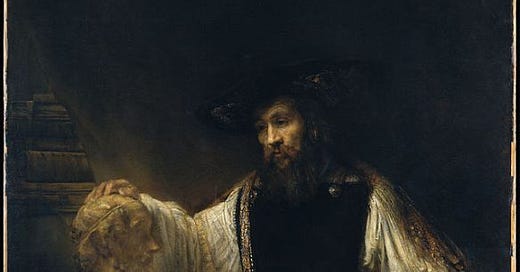Rembrandt’s ‘Aristotle contemplating a bust of Homer’
The cover image for my new book: Rembrandt’s ‘Aristotle contemplating a bust of Homer’
Posted on November 15, 2014
Aristotle with a Bust of Homer Rembrandt (Rembrandt van Rijn) (Dutch, Leiden 1606–1669 Amsterdam)
This is the image we’re using for the cover of my book Imagined worlds and classroom realities, to be released later this year or early in 2015.
I saw this painting a couple of years ago, in the Met in New York, and the first thing that struck me was the deep thoughtfulness in the philosopher Aristotle’s eyes as he reaches out and rests his right hand on the bust of the storyteller Homer. He seems more than lost in thought. He’s also full of feeling, wondering perhaps about the place of poetry and mythology – with their evocations of beauty, love, courage, truth and the good – in his thinking about the world.
Then I remembered that Aristotle was a teacher. In fact we can just see the image of his most famous pupil, Alexander the Great, on the medallion which hangs from the chain around his neck. Aristotle’s left hand is touching the chain, a gift from Alexander, representing (perhaps) Aristotle’s connection to the world of action, power and the everyday.
These two – the mythopoetic represented by Homer’s bust and the political represented by Alexander’s chain – are the teacher’s worlds. We necessarily pay attention to everyday necessities and realities – the bells, routines, timetables, expectations, demands, complexities, resistances, power dynamics and so on. We try to stay in touch with the values that brought us into teaching in the first place, and which animate our best moments in the classroom.
The stories in my book are attempts to represent this ‘living in two worlds’, this reaching out to stay in touch with what we care most deeply about amidst our classroom realities.





